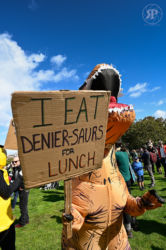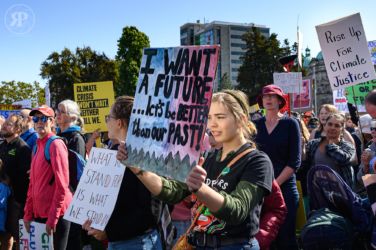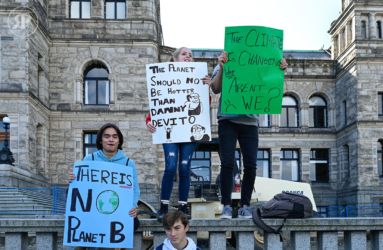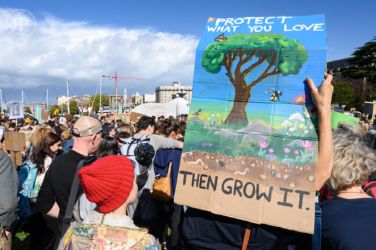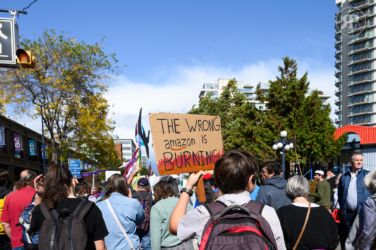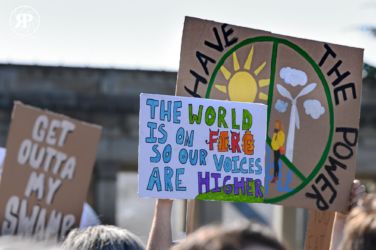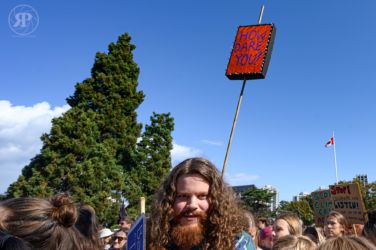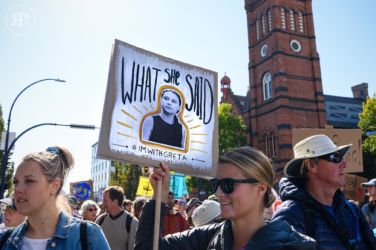.jpg)
Verifiable
“My message to all the politicians is the same: listen to the science, act on the science” ~Greta Thunberg, Montreal, September 17, 2019
Ball in court
About fifteen-years-ago I came under fire from the then-managing editor of Victoria’s Times Colonist newspaper. What might have attracted the email broadside, consisting solely of ad hominem insult? I had accused the paper’s editors of bias in their coverage of climate change after they refused to allow me to counter the disinformation campaign run through the paper’s editorial department, featuring pet global warming denier, Tim Ball.
My 800-word counterpoint came to the TC recommended by a leading author of the United Nations Intergovernmental Panel on Climate Change. It unpacked and debunked the mendacious talking points the paper had allowed Ball to broadcast in their pages over hundreds of column inches in regular op-eds and letters.*
Ball eventually became a liability to Canadian newspaper magnates, especially when he sued the Calgary Herald for defamation after it allowed a brief letter from a real professor of environmental science questioning Ball’s shaky credentials. The newspaper that had appended those credentials to no less than 8 episodes of Ball’s balderdash now submitted in their defence that “Ball is a member of the Friends of Science, a group dedicated to discrediting mainstream scientific beliefs and theories regarding the contribution of human sourced greenhouse gases to global warming.” Fact-checking had come to the Herald, albeit via their lawyers.
Since then, Ball has had to defend himself against lawsuits brought by climate scientists he has defamed. The Supreme Court of British Columbia has dismissed suits by Canadian scientist (now Green Party MLA) Andrew Weaver (my technical guarantor, mentioned above) and, this summer, U.S. climatologist and geophysicist Michael E. Mann, not as denier hoards would have you believe, because Ball has won a victory against the men, but because, as Mann’s lawyers explain, judges ruled Ball’s senescent claims so impotent that they were unlikely to damage the career of a reputable scientist. If Ball won anything, it was the argument advanced in his defence that he is old, sick and irrelevant.
Fact-checking for idiots
Of course, the TC was not the only paper enabling the climate confusion campaign; most Canadian newspapers were, and still are, in on the scam, under the ruse of “balanced reporting” … and not just editorial departments. I have clippings from the dailies — front page stories manufactured out of whole cloth, or the material that denier lie factories — The Heritage Institute, Cato Institute, Fraser Institute and dozens more — have concocted to stall public policy that might have lessened destructive climate change.
My run-in with editors did not start at the TC. Five-years before my contretemps with the cantankerous Colonist conspirator, I lost my freelance access to another (now defunct) Vancouver Island newspaper, whose editor dismissed me from his office with the admonition “I won’t allow environmental advocacy in my newspaper!”
I had, you see, followed up a story quietly handed over to me by a veteran Vancouver Sun columnist. In words and pictures, I documented how the city, a multinational logging corporation and other “stakeholders” managed the forested valley containing the municipal reservoir. In the course of my investigation, I discovered that one of the private partners, developer of intensive silviculture practices that included genetically “improved” trees and toxin-laced fertilizers, also held the contract for safety-testing of the town’s drinking water supply.
Notwithstanding that the raison d’être of the establishment media is advocacy for the status quo, however malignant its effects on society, I had pursued a story that, if run, might damage advertising revenues, upset the area’s main employer, and promote the public good.
The red-faced apoplexy didn’t end with my exit from the editor’s office. Word got around, especially after a town hall meeting sponsored by a local church and, through private sponsorship, the publication of my investigation “A logging road runs through it.” Along with fellow advocates, I was harassed from the mayor’s office down to shadowy thugs and, no surprise, editorials from the aforementioned editorialist-in-chief.
.jpg)
Rock & Roll Wisdom
Saint Eugene versus the gangsters of Minamata
When W. Eugene Smith and his wife Aileen travelled to Japan to document the horrors of “Minamata disease,” did they look through their cameras’ viewfinder with dispassionate eye?
Smith made hundreds of photos of the effects of methyl mercury poisoning in the Kyushu district fishing village and one-company-town between 1971-73. The most iconic image from the photo essay, “Tomoko Uemura in Her Bath, from Minamata, 1972,” carefully made with the cooperation of Tomoko’s family, became known as “The Madonna of Minamata,“ bringing worldwide attention to the plight of villagers poisoned by pollution from the Chisso Corporation chemical plant.
Chisso hired Yakuza goons who beat Smith so severely that he was temporarily blinded and in such agony that he begged his wife to kill him.
The lens through which the human eye doth gaze
And so, belatedly, we approach the question contained in the title of this post. While a photograph of, say, Donald Trump meeting Vladimir Putin or the historic, 1959 Elliot Erwitt photo of Richard Nixon poking Soviet Premier Nikita Khrushchev in the chest, need not overtly “take sides,” through the greater context of his work or one definitive image that points to inescapable truth, a photographer may “influence the outcome.”
For those of us safe at home, our vague understanding of the ravages of war comes from world-changing photos made by Eugene Smith and Robert Capa during World War II. In Vietnam, Nick Ut’s napalmed girl (Kim Phuc, now living in Toronto) on the Trang Bang road; Larry Burrows’ Gunnery Sergeant Jeremiah Purdie, bandaged and bleeding in the mud; Gilles Caron’s documentation of the Phoenix Program, America’s scorched earth campaign against the Viet Cong and civilians alike; Don McCullin’s shell-shocked soldier; Phillip Jones Griffiths’ napalm burn victim, tagged like excess baggage, and the harrowing record of savagery later collected in his book Vietnam, Inc. — these indelible images reach beyond words, directly into our hearts.
Surely these photographers did not risk their lives to glorify carnage. We know that many, like Nick Ut, whose brother died covering the war in Vietnam, took their cameras into conflict zones with the express hope that their photographs might bring an end to war. Their work was such a success in this regard that, in recent conflicts, photographers have been kept on a short leash, “embedded” with armies, their work vetted by generals lest it advocate wrongly.
I refer to these examples of “photographic evidence” as an antidote to the scourge of “fake news,” arrayed against fact by scoundrels and concocted, often by the same sociopaths, to sow doubt in the minds of the public.
Call it advocacy or chasing the truth, words and photographs that “comfort the afflicted and afflict the comfortable” often attract retribution, instead of praise.
.jpg)
“You come to us young people looking for hope. How dare you!” ~Greta Thunberg at the United Nations, September 23, 2019
Climate of fear, climate of hope
Which brings us around, again circuitously, to today’s most pressing issue, climate change, and 16-year-old Swedish protestor Greta Thunberg who has emerged as a high profile crusader for political action to address the crisis. Last week, millions of youth flooded streets of cities and towns around the world, answering the call of Thunberg’s “Skolstrejk för klimatet.”
As Thunberg’s influence has grown, affording her access to world leaders and inspiring climate strikes among her peers across the globe, so have insults and threats so cowardly and scurrilous that I hesitate to speak more of it here but to note that the hate speech is perpetrated by the usual global warming denier cabal I’ve already identified.
Though the worst of these are being disowned, at least publicly, by the corporate media, last week influential fanatic Dinesh D’Souza posted a picture to his 1.3 million followers on Twitter of a pigtailed girl on a vintage Nazi propaganda poster next to a photo of Thunberg, claiming “Today’s progressive Left is still learning its game from an earlier Left in the 1930s.” Apparently D’Souza is unaware, by ignorance or design, that Hitler’s nihilists arose from the extreme right of the political spectrum he now inhabits.
As I say, I hesitate to draw attention to such diseased rhetoric, but that deniers are now willing to excite hatred against children indicates a new level of desperation and (despite Thunberg’s hesitation to believe such intent) malevolence.
It was these obscene insults — hurled, remember, at a 16-year old girl — as much as Thunberg’s extraordinary speech to the United Nations on Monday 23 September, that convinced my wife and I to ignore a flu bug almost as filthy as the fulminations of the deniers to support striking students in Victoria, last Friday.
One or two of the photographs on this page will join my existing “Faces of Resistance” gallery, which may or may not, depending on your disposition, contain a point-of-view.
.jpg)
Rising Tide
The haters like to dismiss youthful protestors as too naive to understand politics. They say, without irony, that they are brainwashed puppets.
Every school-age climate striker I listened to on Friday impressed me with their eloquence and a maturity beyond their age. They recognize the institutionalized corruption of the petro-state. They know that democracy is threatened by the absurd theatre of elections as they stand, where the faces of political actors change without affecting the work of backroom operatives who carry on corporate business as usual. From Ottawa to Calgary to the Parliament Buildings that were backdrop to the Victoria protest, you’ll find these quiet bureaucrats zealously serving their masters and the fictions that underpin their power.
The Times Colonist avoided an estimate of attendance by saying the crowd “rivalled that of Canada Day celebrations,” which have in the past exceeded 70,000 people. In Vancouver, the protest topped 100,000. In Montreal, where Thunberg was awarded the keys to the city and the protection of the mayoral security apparatus, the rally attracted over half a million marchers.
By Sunday, there was no sign on the Times Colonist website of former stories covering the Victoria climate strike (clicking through to “Most Recent” didn’t help), only a business headline, “Climate strikers naive but have right to protest, say energy sector leaders.”
The Georgia Straight counted no less than 39 opinion pieces and 32 letters to the editor — “an incredible 44,500 words” — carrying Ball’s byline in 24 Canadian newspapers, between 2001 and 2007.


















